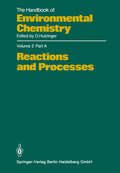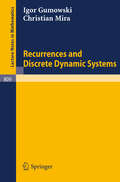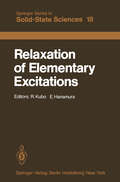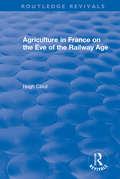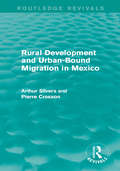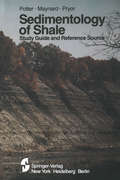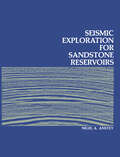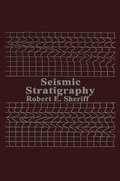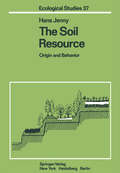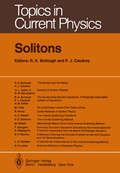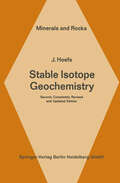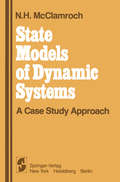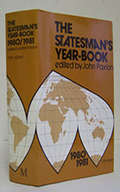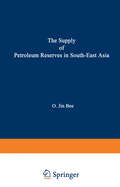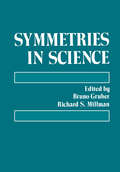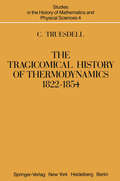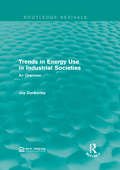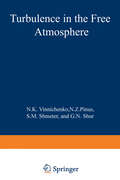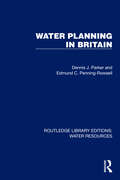- Table View
- List View
Reactions and Processes (The Handbook of Environmental Chemistry #2 / 2A)
by G. L. BaughmanEnvironmental Chemistry is a relatively young science. Interest in this subject, however, is growing very rapidly and, although no agreement has been reached as yet about the exact content and limits of this interdisciplinary discipline, there appears to be increasing interest in seeing environmental topics which are based on chemistry embodied in this subject. One of the first objectives of Environmental Chemistry must be the study of the environment and of natural chemical processes which occur in the environment. A major purpose of this series on Environmental Chemistry, therefore, is to present a reasonably uniform view of various aspects of the chemistry of the environ ment and chemical reactions occurring in the environment. The industrial activities of man have given a new dimension to Environ mental Chemistry. We have now synthesized and described over five million chemical compounds and chemical industry produces about hundred and fifty million tons of synthetic chemicals annually. We ship billions of tons of oil per year and through mining operations and other geophysical modifications, large quantities of inorganic and organic materials are released from their natural deposits. Cities and metropolitan areas of up to 15 million inhabitants produce large quantities of waste in relatively small and confined areas. Much of the chemical products and waste products of modern society are released into the environment either during production, storage, transport, use or ultimate disposal. These released materials participate in natural cycles and reactions and frequently lead to interference and disturbance of natural systems.
Recurrences and Discrete Dynamic Systems (Lecture Notes in Mathematics #809)
by Igor Gumowski Christian MiraRelaxation of Elementary Excitations: Proceedings of the Taniguchi International Symposium, Susono-shi, Japan, October 12–16, 1979 (Springer Series in Solid-State Sciences #18)
by R. Kubo E. HanamuraThis is the Proceedings of the Taniguchi International Symposium on "Relaxation of Elementary Excitations" which was held October 12-16,1979, at Susono-shi (at the foot of f1t. Fuji) in Japan. The pleasant atmosphere of the Symposium is evidenced in the picture of the participants shown on the next page. The purpose of the symposium was to provide an opportunity for a limited number of active researchers to meet and to discuss relaxation processes and related phenomena not only of excitons and phonons in solids but also electronic and vibrational excitations in molecules and biological systems. First, the lattice relaxation, i.e., multi-phonon process, associated with electronic excitation, which plays important roles in self-trapping of an exciton and a particle (electron and hole) and also in degradation of semi conductor lasers, is discussed. Second, this lattice relaxation is studied as the intermediate state interaction in the second-order optical responses, i.e., in connection with the competitive behavior of Raman scattering and luminescence. Third, relaxation mechanisms and relaxation constants are by spectroscopic methods as well as by genuine nonlinear optical determined phenomena. Conversely the relaxation is decisive in coherent nonlinear optical phenomena such as laser, superradiance, and optical bistability. Fourth, the role played by relaxation processes is discussed for optical phenomena in macromolecules and biological system such as photosynthesis.
Routledge Revivals: Agriculture in France on the Eve of the Railway Age (Routledge Revivals)
by Hugh CloutFirst published in 1980, this compact and useful book uses the earliest volumes of government-published statistics, and with the aid of computer-generated cartography, transforms the numbers there reported into an arrondissement-by-arrondissement comparative picture of French agriculture in the mid-1830s. Clout reviews problems of rapid population growth, scarcely adequate domestic food supplies and primitive systems of transportation, while attention is drawn to spatial variations in agricultural activity and productivity. Commercial, high-yielding farming was best developed in a northern multi-nuclear region, comprising of Ile-de-France, Normandy and Nord, with smaller foci of commercial orientation along an eastern axis from Alsace to Marseilles and in western areas from the Loire to the middle of the Garonne valley. Clout concludes that the revolutionary promise of national economic unity was far from being realised in the 1830s and was not to be achieved until national systems of transport and education were firmly established later in the nineteenth century.
Routledge Revivals: Agriculture in France on the Eve of the Railway Age (Routledge Revivals)
by Hugh CloutFirst published in 1980, this compact and useful book uses the earliest volumes of government-published statistics, and with the aid of computer-generated cartography, transforms the numbers there reported into an arrondissement-by-arrondissement comparative picture of French agriculture in the mid-1830s. Clout reviews problems of rapid population growth, scarcely adequate domestic food supplies and primitive systems of transportation, while attention is drawn to spatial variations in agricultural activity and productivity. Commercial, high-yielding farming was best developed in a northern multi-nuclear region, comprising of Ile-de-France, Normandy and Nord, with smaller foci of commercial orientation along an eastern axis from Alsace to Marseilles and in western areas from the Loire to the middle of the Garonne valley. Clout concludes that the revolutionary promise of national economic unity was far from being realised in the 1830s and was not to be achieved until national systems of transport and education were firmly established later in the nineteenth century.
Rural Development and Urban-Bound Migration in Mexico (Routledge Revivals)
by Arthur Silvers Pierre CrossonRapid growth of urban populations is a major characteristic of economic development and demographic change in developing countries leading to industrialisation and modernisation of major cities. Originally published in 1980, this study focusses on these issues using Mexico as a case study as well as analysing the risk of over-urbanisation and what the effects will be on cities such as Mexico City. This title will be of interest to students of Environmental studies and Economics.
Rural Development and Urban-Bound Migration in Mexico (Routledge Revivals)
by Arthur Silvers Pierre CrossonRapid growth of urban populations is a major characteristic of economic development and demographic change in developing countries leading to industrialisation and modernisation of major cities. Originally published in 1980, this study focusses on these issues using Mexico as a case study as well as analysing the risk of over-urbanisation and what the effects will be on cities such as Mexico City. This title will be of interest to students of Environmental studies and Economics.
Sedimentology of Shale: Study Guide and Reference Source
by Paul E. Potter J. Barry Maynard Wayne A. PryorWe wrote Sedimentology of Shale primarily because we lacked a handy, reasonably comprehensive source of information and ideas about shales for students in our sedimentology program. It was also our feeling that the time for shales to receive more study had finally arrived. Sedimentology of Shale also seems very timely because today more sedimentologists are interested in shales. Certainly in the last five years the pace of shale research has no ticeably quickened because the role of shales as important sources of oil, gas, heavy metals and as a long understudied part of the earth's geologic his tory has been recognized. Noteworthy developments include the elucida tion of the importance of trace fossils in shales, the discovery of thick sequences of overpressured shales in regions such as the Gulf Coast (which have important implications for hydrocarbon migration and faulting), the ex tension of the principles of metamorphic facies to the realm of low tempera ture diagenesis by study of the organic matter in shales, and shales as ul timate sources for mineral deposits. Accordingly, we decided it was timely to write a book on shales. In one respect, however, ours is an unusual book. Most books in geology are produced after one or two decades of progress have been made in a field and attempt to summarize and evaluate that progress.
Seismic Exploration for Sandstone Reservoirs
by N.A. AnsteyThis text was originally written for use with the videotape program of the same title. Numbered video cassettes correspond to the following chapters of the book: Tape Chapter(s) Tape Chapter(s) 1 1-2. 2. 1 11 3. 4 2 2. 2. 2-2. 3 12 3. 5. 1-3. 5. 2 3 2. 4 13 3. 5. 3 4 2. 5-2. 6 14 3. 5. 4-3. 6. 3 5 2. 7-2. 8 15 3. 7-3. 7. 2 6 3 16 3. 8-4 7 3. 1 17 4. 1 8 3. 2-3. 2. 1 18 4. 2-4. 4 9 3. 2. 2-3. 2. 3 19 5 10 3. 3 Complete information about the videotape program, Seismic Exploration for Sandstone Reservoirs may be obtained from: IHRDC, 137 Newbury St. , Boston, MA 02116, (617) 536-0202. Acknowledgements Thanks are expressed to the authors, companies and professional associations who have allowed the use of their material in the course. The author and publisher are grateful for permission to reproduce material whose copyright belongs as follows: Figures: 2. 4-3 (Widess) SEG; 2. 4-4 (Prescott) Continental Oil Company; 3-1 (Le Blanc) AAPG; 3-2 (MacKenzie) AAPG; 3. 1-1 Seiscom Delta; 3. 1-3 (Schramm et al. ) AAPG; 3. 1-4 (Lamer et al. ) Western Geophysical Company; 3. 2. 2-2 Prakla Seismos; 3. 2. 2-3 (Leung et al. ) Amoco Europe; 3. 2. 2-4 (Newman et al. ) S&A Geophysical; 3. 2. 3-2 Seiscom Delta; 3. 3-1 (Taner) Seiscom Delta; 3.
Seismic Stratigraphy
by R.E. SheriffEvery little wiggle has a meaning all its own. This is our underlying faith, that details of seismic waveshapes can tell us the details of the nature of the earth. But their voices are obscured by many irrelevancies. They speak in a high-noise environment, and we have been able to decipher only a small portion. However, things are looking up: better tech niques are lessening the irrelevancies, and we are learning to read. In exploration of unknown areas, determining the nature of the rocks present is often the difficult aspect. Most of the properties of rocks that can be measured at a distance are not distinctive enough to identify the rock unambiguously. Con ventionally, seismic data are used to determine aspects of the structure. Stratigraphic pictures are inferred from the struc ture, the nature of rocks exposed for examination in the sur rounding area, and regional concepts. Three points make seismic stratigraphy feasible now: (1) we have better data quality, (2) we have begun to sys tematize analysis procedures, and (3) we believe in the geologic significance of waveshape details.
Seminaire sur les Singularites des Surfaces: Centre de Mathematiques de l'Ecole Polytechnique, Palaiseau 1976-1977 (Lecture Notes in Mathematics #777)
by M. Demazure H. Pinkham B. TeissierThe Soil Resource: Origin and Behavior (Ecological Studies #37)
by Hans Jennychange is simply described by the rate of income and rate of loss. Our home's energy budget, our firm's inventory, our nation's debt, and humanity's numbers all have accounts that change at rates that are equal to the inputs minus the outputs. Jenny's "system view" of the soil was carried into the fertile fields of Midwestern American prairies from the laboratories of Switzerland in the late 1920s. Jenny's rate equations provided the other paradigm or world view that, I recall, brought us to the threshold of systems ecology as it later evolved in the second half of the twentieth century. As if world renown in the specialties of pedology and soil chemistry were not enough for one lifetime, excerpts below remind us that Hans Jenny has also been a perceptive outdoor field ecologist since his early Alpine expeditions with Braun Blanquet in the mid 1920s. Jenny's ecosystem studies in the pygmy forest, a further classic example of a soil-plant system "run down" over hundreds of thousands of years since its origin, continue to occupy some of the vigorous retirement time near his farm in Mendocino County. But each specific, quantitative case study, and each research area conserved (with additional hard work) for further study by future generations, fits into Jenny's coherent world view. It is that view, and its legacies of discovery and of tangible landscape preserves, which we are privileged to share with their originator in this volume.
Solar Radiation and Clouds (Meteorological Monographs)
by Ronald WelchThe research reported in this monograph represents an attempt to explore the extreme values as well as the more probable values of the radiative characteristics of water and ice clouds in the solar wavelengths. It discusses topics such as monomodal drop size distributions, cloud thickness, cloud geometry, to the radiative characteristics of clouds and ice crystals.
Solitons (Topics in Current Physics #17)
by R. K. Bullough P. J. CaudreyWith contributions by numerous experts
State Models of Dynamic Systems: A Case Study Approach
by N.H. McClamrochThe purpose of this book is to expose undergraduate students to the use of applied mathematics and physical argument as a basis for developing an understanding of the response characteristics, from a systems viewpoint, of a broad class of dynamic physical processes. This book was developed for use in the course ECE 355, Dynamic Systems and Modeling, in the Department of Electrical and Computer Engineering at the University of Michigan, Ann Arbor. The course ECE 355 has been elected primarily by junior and senior level students in computer engineering or in electrical engineering. Occasionally a student from outside these two programs elected the course. Thus the book is written with this class of students in mind. It is assumed that the reader has previous background in mathematics through calculus, differential equations, and Laplace transforms, in elementary physics, and in elemen tary mechanics and circuits. Although these prerequisites indicate the orientation of the material, the book should be accessible and of interest to students with a much wider spectrum of experience in applied mathemati cal topics. The subject matter of the book can be considered to form an introduc tion to the theory of mathematical systems presented from a modern, as opposed to a classical, point of view. A number of physical processes are examined where the underlying systems concepts can be clearly seen and grasped. The organization of the book around case study examples has evolved as a consequence of student suggestions.
The Statesman's Year-Book 1980-81 (The Statesman's Yearbook)
by John PaxtonThe classic reference work that provides annually updated information on the countries of the world.
The Supply of Petroleum Reserves in South-East Asia: Economic Implications of Evolving Property Rights Arrangements (Natural Resources of South-East Asia)
by Corazón Morales Siddayaowhich may be termed 'political. risks'-may be important deter minants of investment. After taking such risks into consideration in the exploration and development stage, a firm computing the pres ent value of its probable income stream must consider several other factors. In addition to the current rate of production, it must con sider these: (I) engineering limits to the rate of extraction in any given period, (2) physical limits to the total amount of the resource that can be produced within a given location, and (3) limits to the availability of new petroleum sources at the same costs as at the present location. It might be useful at this point to note that the firm as an explo ration agent in South-East Asia operates largely as a contractor to the host government who has ownership and final control over the petroleum resources. The group of suppliers of petroleum reserves in the region is characterized by the presence of the major com panies, directly or through subsidiaries, as well as by many small er, and even independent, companies. Three major companies currently dominate exploration and producing operations in two countries-Exxon and Shell in Malaysia, Shell in Brunei. In Indonesia, Caltex and Stanvac dominate production. Outside Malaysia and Brunei the bulk of new exploration is conducted by relatively smaller companies side-by-side with the major companies like Exxon, Gulf, Mobil, Shell, and Texaco.
Symmetries in Science
by Bruno GruberSouthern Illinois University at Carbondale undertook to honor Albert Einstein as scientist and as humanitarian in commemo ration of his lOOth birthday during an "Albert Einstein Centennial Week", February 23 - March 2, 1979. During the course of this week two Symposia were held, entitled "Symmetries in Science" and "Einstein: Humanities Conscience", in addition to cultural and social activities honoring Einstein. This volume presents the Symposium "Symmetries in Science". It reflects the outstanding response that was given to our "Albert Einstein Centennial Week" by the international community of scientists. The motivation to have a celebration honoring Albert Einstein at Southern Illinois University at Carbondale was supplied by Dr. Paul A. Schilpp, the editor of the "Library of Living Philo sophers". Albert Einstein has contributed to this series with his autobiographical notes, a kind of autobiography of his scientific life, in a volume entitled "Einstein: Scientist-Philosopher", the most popular among all the outstanding volumes of this series. Dr. Paul A. Schilpp's presence at Southern Illinois University at Carbondale provided a natural link for an Einstein Celebration as a kind of a continuation of the contribution he made to mankind through the Einstein volume of his "Library of Living Philosophers".
The Tragicomical History of Thermodynamics, 1822–1854 (Studies in the History of Mathematics and Physical Sciences #4)
by C. TruesdellTrends in Energy Use in Industrial Societies: An Overview (Routledge Revivals)
by Joy DunkerleyTaken from a report for the Electric Power Research Institute, Joy Dunkerley’s study aims to clarify the relationship between energy consumption and economic output in industrialised countries. Originally published in 1980 and using data from 1972, this study uses cross-country comparisons of energy use to stress the importance of new supply options and measures of controlling energy use without affecting living standards whilst also discussing the impact of energy prices and economic growth in the countries studied. This title will be of interest to students of environmental studies.
Trends in Energy Use in Industrial Societies: An Overview (Routledge Revivals)
by Joy DunkerleyTaken from a report for the Electric Power Research Institute, Joy Dunkerley’s study aims to clarify the relationship between energy consumption and economic output in industrialised countries. Originally published in 1980 and using data from 1972, this study uses cross-country comparisons of energy use to stress the importance of new supply options and measures of controlling energy use without affecting living standards whilst also discussing the impact of energy prices and economic growth in the countries studied. This title will be of interest to students of environmental studies.
Turbulence in the Free Atmosphere
by N. VinnichenkoTurbulence-the randomly disordered movement of volumes of air of widely varying size-is one of the characteristic features of atmospheric air flows; its investigation is essential for the solution of several theoretical and practical problems. Until recently, owing to experimental difficulties, research on turbu lence was confmed mainly to the lower half of the troposphere. Theoretical investigations have consequently been based on these data. The rapid development of high-altitude aviation and cases of aircraft encoun tering hazardous turbulence led to a sharp intensification of research on turbu lence in the atmosphere up to 10-12 km, and subsequently at greater altitudes. Such research was confined initially to the characterization of the frequency of occurrence of gusts of different speeds, their relation to altitude, geographical conditions, time of day and year, and so on. At the end of the fifties, when the required measuring equipment and experimental techniques had been developed, it became possible to investigate the complete statistical characteristics of turbu lence: the spectral densities of the velocity fluctuations of air flows, structure functions, etc. These data stimulated the further development of theory related to the specific conditions of the free atmosphere.
Water Planning in Britain (Routledge Library Editions: Water Resources)
by Dennis J. Parker Edmund C. Penning-RowsellOriginally published in 1980, this book provides a penetrating and scholarly analysis of the planning of water resources, based on 10 years’ of research into one of Britain’s most vital industries. At the time of original publication Britain had a plentiful natural supply of water, but accessible clean water was scarce; droughts were not uncommon, floods often caused considerable damage; water bills were rising dramatically and consumption increasing inexorably. All of which applies as much to water resources in the UK today. Water planners must strike a delicate balance between many conflicting social, environmental, political and financial demands. Britain’s water authorities are large and autonomous organisations subject to constant change and controversy. Water policies affect not only water but also land-use planning, recreation planning, environmental quality, food production and the maintenance of public health. The book explains common threads and issues in the planning of 4 main water functions: water supply, effluent disposal and pollution control, water recreation and amenity and land drainage and flood alleviation. 11 original British case studies have been selected to illustrate the issues involved. The final chapter presents a critical and controversial evaluation of water policy and planning institutions in Britain, highlighted by some international comparisons.
Water Planning in Britain (Routledge Library Editions: Water Resources)
by Dennis J. Parker Edmund C. Penning-RowsellOriginally published in 1980, this book provides a penetrating and scholarly analysis of the planning of water resources, based on 10 years’ of research into one of Britain’s most vital industries. At the time of original publication Britain had a plentiful natural supply of water, but accessible clean water was scarce; droughts were not uncommon, floods often caused considerable damage; water bills were rising dramatically and consumption increasing inexorably. All of which applies as much to water resources in the UK today. Water planners must strike a delicate balance between many conflicting social, environmental, political and financial demands. Britain’s water authorities are large and autonomous organisations subject to constant change and controversy. Water policies affect not only water but also land-use planning, recreation planning, environmental quality, food production and the maintenance of public health. The book explains common threads and issues in the planning of 4 main water functions: water supply, effluent disposal and pollution control, water recreation and amenity and land drainage and flood alleviation. 11 original British case studies have been selected to illustrate the issues involved. The final chapter presents a critical and controversial evaluation of water policy and planning institutions in Britain, highlighted by some international comparisons.
